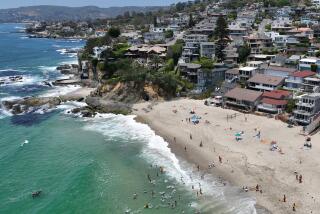Op-Ed: Who gets to enjoy California’s natural treasures? The right answer should be ‘everyone’
As surfers growing up in landlocked San Bernardino, we’d talk our older friends into driving west after school on Fridays, then sleep in a rest area near Encinitas so we could paddle out by daybreak. When territorial locals bombarded us with rocks from the cliffs above, we’d curse and return fire.
But we understood. What we didn’t get was people sprawled in their oceanfront homes watching “Go-Go Gophers” cartoons as another glorious day at the beach unfolded below. California, we thought, needed a law: Individuals shall be forbidden from living within one mile of the Pacific Ocean unless they can demonstrate a near-rapturous passion for frolicking in the waves.
I was reminded of our youthful sense of injustice after reading that the California Coastal Commission has, at least for the moment, thrown in the beach towel on its historic — heroic in my view — fight for people’s right to cut through a development known as Hollister Ranch to reach an isolated, 8 ½-mile stretch of the Central Coast.
The case has dragged on for decades, with attorneys for the ranch fighting to exclude the public while the California Coastal Commission and Coastal Conservancy argued that the ranch’s wealthy landowners were obligated to respect an easement that predates the 14,000 acres’ formal development.
The question of who is entitled to California’s natural treasures is an urgent one. Up and down the coast, landowners have long fought to barricade routes to the shore, and now billionaire Vinod Khosla is asking the U.S. Supreme Court to reverse a lower court ruling and let him keep people off a beach near Half Moon Bay that he thinks he owns.
He doesn’t. Yet.
California’s revolutionary State Coastal Act of 1976 set out to protect California’s 1,100 miles of shoreline and the people’s right to access it. Its champions assumed what common sense suggests: that humans will buy and hoard whatever they cherish; that, left to their devices, coastal property owners will eventually erect a line of fences from Tijuana to the Oregon border, locking out the rest of us, even though the law makes clear that up to the mean high tide line, the beaches belong to all of us.
There are 40 million of us in California and we all need our beaches.
For those of us who worship what’s left of wild California, the battle over “the Ranch” poses a moral conundrum. We understand the instincts of those who have bought full or partial ownership in one of the ranch’s parcels to protect its near-pristine beach, rolling oak hills and working ranchland. We’d be hypocritical to begrudge singer-songwriter Jackson Browne, Patagonia founder Yvon Chouinard, producer-director James Cameron and other Hollister landowners their investment in this throwback to California’s coast before we buried it under 7-11s and condos. We get the desire to ride the Ranch’s exquisitely shaped waves absent a logjam of cartwheeling boards and bodies.
But it seems possible to love a place, and to protect it, without hiring lawyers and a militia of armed guards to intimidate the rest of us as we try to assert our legal right to a sliver of this landscape.
In giving preliminary approval to the Coastal Commission settlement — no public land access except for a limited number of escorted groups of school kids and the like — Santa Barbara Superior Court Judge Colleen Sterne took the unusual step of requiring a period of public discussion.
The delay gives the judge a chance to reconsider. And it gives the commissioners — many of them newly appointed and perhaps eager to improve the tarnished image of an agency that in recent years has been far too cozy with rich and politically well-connected developers — time to reexamine the Coastal Act’s purpose.
Read the ads peddling ranch parcels — some with tennis courts and infinity pools — and you’ll see that one of the most frequently used selling words is “exclusive.” The battle is, at its core, not only about access to California’s coast but about access to life’s sublime pleasures.
In offering what for some buyers will be a second or maybe 15th home, one real estate purveyor makes this pitch: “The owners who have been lucky enough to find a spot on the Ranch have found that the beauty and the serenity have further enriched their lives. It is because being part of this large, beautiful place allows one to have alone time that can be so important to everyone.”
I wrote this op-ed, in part, from a campsite at San Clemente State Beach, which was packed with people of every ethnic and economic background from all over the state and world. Competition for reservations at state beaches is fierce, no longer cheap, and development is creeping up to the edges of many.
Older now, I’m learning to appreciate the joy of sharing what I love. I’ve expanded my view of who is entitled to enjoy the California coast: Not just the father who comes whooping out of the water with his two young sons, all clutching surfboards, but the toddlers building sand castles, the arguing couple and the man with the long, white hair who sits at the base of the cliff playing guitar.
There are 40 million of us in California and we all need our beaches. We have until July 23 to email the commissioners at Hollister@coastal.ca.gov and say that we are relying on them to expand rather than constrict the rights of “everyone” to feel the slosh of cold water on bare feet, along even the most secluded stretches of our coast.
Bob Sipchen is a former editor of the Times Sunday Opinion pages and Outdoors section and, with Alex Raksin, won a Pulitzer Prize for editorial writing. He teaches in the Writing and Rhetoric Department at Occidental College.
Follow the Opinion section on Twitter @latimesopinionand Facebook
More to Read
A cure for the common opinion
Get thought-provoking perspectives with our weekly newsletter.
You may occasionally receive promotional content from the Los Angeles Times.










